The history of marijuana has become a hot topic in recent years, with numerous states pushing for similar legalization efforts. This fascinating plant has been used throughout history to treat a vast array of ailments and has undergone significant transformations in its societal perception and legal status. Our editors will review the intriguing journey you’ve submitted and determine the most accurate and engaging way to chronicle this complex narrative. As we delve into the rich past of cannabis, from ancient medicinal use to modern legalization movements, we invite you to join us. If necessary, we’ll revise the article to ensure it provides the most comprehensive and up-to-date information. So stay tuned as we unroll the history of marijuana – a tale you’ve submitted and one that continues to evolve.
Unraveling the Chronicles of Cannabis: A Deep Dive into the History of Marijuana
The chronicles of Cannabis, more commonly known as marijuana, have become a hot topic in today’s society, especially with numerous states pushing for similar legalization efforts. This intriguing journey began thousands of years ago. The first documented use of cannabis can be traced back to 2737 BC when Chinese Emperor Shen Nung was said to have discovered its medicinal properties. Fast forward to the 20th century, the United States saw a wave of cannabis criminalization, which has since been challenged by modern movements pushing for similar legalization across the nation. Today, the narrative around marijuana is evolving, as more states are recognizing its potential benefits. As we delve deeper into the history of this complex plant, we uncover fascinating insights about its past, and perhaps, clues about its future.
Exploring the Past: A Comprehensive Journey through the History of Marijuana
Our journey through the history of marijuana, or Cannabis sativa, takes us through centuries of its use, from medicinal purposes to recreational enjoyment. The story commences over 5000 years ago when archaeological evidence suggests that marijuana was likely used as a medicinal plant in Asia. Fast forward to the 19th century, the United States began to recognize the potential benefits of medicinal marijuana, using it widely for various treatments.
However, the early 20th century saw a shift in perception, with the US government criminalizing marijuana due to concerns over its physical effects and potential for abuse. This led to a long period of prohibition, which lasted for much of the 20th century. It’s only in recent decades that the tide has started to turn again, with an increasing number of states legalizing medicinal and even recreational use of marijuana.
An interesting aspect of the plant’s history involves the cultivation and use of female marijuana plants. These plants are often preferred by growers and users alike for their higher concentrations of THC, the chemical responsible for most of marijuana’s psychological effects. Over time, cultivation methods have evolved to favor these female plants, reflecting the changing demands of users.
In conclusion, the history of marijuana is a complex tapestry woven with threads of medical advancement, societal change, and evolving attitudes. It’s a history that continues to be written today, as we continue to explore the potential benefits and risks of this fascinating plant.
The Modern-Day Role: Marijuana’s Place in the 21st Century
The history of marijuana, dating back to Emperor Shen Nung’s pharmacopeia some 5000 years ago, has seen numerous shifts in societal perception and usage. Today, marijuana’s place in the 21st century is a hot topic, particularly in the United States. Once viewed as a harmful substance, it’s now being reevaluated for its potential therapeutic benefits.
The US, once a stronghold of marijuana prohibition, is witnessing a wave of change. More states are pushing for similar legalization of medicinal and recreational use, challenging federal laws and norms. This shift reflects a growing recognition of marijuana’s potential benefits, especially in managing chronic pain, anxiety, and several other health conditions.
However, as we embark on this new chapter, it’s crucial to remember that the story of marijuana is far from over. As research continues and regulations evolve, the role of marijuana in the 21st century will continue to be shaped by scientific discovery, public opinion, and policy debates.
Manifestations on the Body: The Impact of Marijuana
Tracing back the history of marijuana, we find its roots in central Asia or western China, where it was used for its alleged healing properties. Over millennia, its use spread across the globe, eventually reaching the United States. Here, it was initially embraced as a medicinal remedy, but over time, concerns grew about its physical effects.
The impact of marijuana on the body is a multifaceted topic. While research shows that medicinal marijuana can provide relief for various ailments such as chronic pain, anxiety, and certain types of seizures, there are also potential adverse effects to consider. These might include short-term memory problems, altered judgment, coordination issues, and in high doses, psychosis.
However, the perception and legality of marijuana have been evolving in recent years. In the United States, a growing number of states are pushing for its legalization, particularly for medicinal purposes. This shift reflects a growing recognition of marijuana’s potential therapeutic benefits, despite the physical effects that may come with its use.
Unraveling the Mystery of Tetrahydrocannabinol: An In-Depth Look at THC
From its humble beginnings in the Shen Nung pharmacopeia, marijuana’s journey has been complex and multifaceted. Over the centuries, it has moved from being a revered medicinal plant to a controversial substance debated worldwide.
In recent times, there has been a renewed interest in the potential therapeutic benefits of marijuana, particularly THC. This shift reflects an evolving understanding of this remarkable plant, which continues to influence our perspectives on health, law, and society.
Marijuana’s rich history, intertwined with the story of THC, is a testament to the plant’s enduring relevance. As we continue to explore its potential, the story of marijuana and THC will undoubtedly remain a compelling chapter in our shared human experience.
Legality
The current legal landscape for marijuana is a patchwork of differing state laws and federal regulations. While some states have fully legalized the use of marijuana, others only allow it for medicinal purposes, and some still fully prohibit it. This disparity creates a complex and often confusing environment for users and providers of marijuana.
While the legalization movement continues to gain traction, the debate over marijuana’s place in our society is far from over. As research continues and public opinion evolves, the legal status of marijuana will undoubtedly continue to be a contentious issue.
Conclusion
The history of marijuana is not just a story about a plant, but also a reflection of societal change, medical advancements, and ongoing discussions about drug policy reform. As research continues and attitudes evolve, the story of marijuana will persist, shaping and being shaped by our understanding of this remarkable plant.




